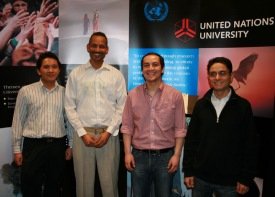MSc defence by Alejandro Rodríguez Badilla

The water-silicic rock interaction under geothermal conditions was studied both experimentally and using reaction path simulations to get insights into to the process of rock alteration including secondary mineralogy, water chemistry and mass transfer as a function of rock composition and reaction progress (ξ). The experiments and model calculations were conducted at 240°C and water vapour saturation pressures on two glass samples, dacite from Askja and rhyolite from Hekla, and inital non-thermal groundwater containing ~5000 ppm NaCl, ~1600-3500 ppm CO2and ~140 ppm H2S. The dissolution of the silicic glasses were found to be incongruent with the formation of secondary minerals on the glass surfaces and in the matrix including quartz, anhydrite, clays like montmorillonite, illite and/or mixed illite-smectite and chlorite, zeolites like analcime and phillipsite as well as traces of anatase and fluorite. Moreover, most of the observed minerals were found to be saturated or supersaturated. The changes in water chemistry were characterized by decrease in CO2, Mg, Fe and Al concentrations, relatively steady concentrations for Na and SO4whereas Si initially rose followed by decrease after ~40 days. For H2S, F and Ca considerable differences were observed depending on the starting material. The formation of secondary minerals greatly reduces the mobility of Al, Fe, Mg and Si and to lesser extend Ca and Na, however, K was observed to be mobile relative to B. The reaction path simulations demonstrate that the appearance of various secondary minerals in a closed system is a function of reaction progress, initially with the formation of clays and sulphides followed by the appearance of quartz and zeolites. Upon considerable reaction (>1 mol rock dissolution in 1 kg of water) other Al-Si minerals also become important and sometimes predominant including epidote, feldspars and chlorite, this last stage closely corresponds to the commonly observed alteration mineralogy associated with geothermal systems hosted by silicic rocks. The exact clay mineralogy was also found to be dependent on the initial system composition, with illite and mixed illite-smectite being more important associated with rhyolites and montmorillonite associated with dacite. In addition, comparison of the experimental results and reaction path simulations revile that reaction kinetics may be of potential importance in the formation of Na, K and Si containing minerals with some profound influences on the respective elemental solution concentrations. This in turn affected the predicted geothermometry temperatures that were found to vary from <150 to >350°C and be a function of the extent of reaction for the 240°C experiments.

